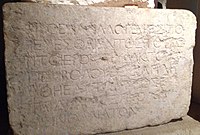Tapınak Uyarı Yazıtı
Tapınak Uyarı Yazıtı, Tapınak Korkuluk Yazıtı ya da Soreg Yazıtı[2] Kudüs'te İkinci Tapınak'taki mabette bulunmuş bir korkuluk yazıtıdır. Hem Latince hem de Grekçe olarak yazılmıştır. Yazıt putperest ziyaertçilere daha fazla ilerleyecekleri takdirde ölüm cezasıyla karşılaşacaklarını söyleyen bir uyarı niteliğindeydi.[3][4]
| Tapınak Uyarı Yazıtı | |
|---|---|
 | |
| Hammadde | Kireçtaşı |
| Yazı | Grekçe |
| Oluşturulma | y. MÖ.23 – MS. 70 [1] |
| Keşfedilme | 1871 |
| Günümüzdeki konumu | İstanbul Arkeoloji Müzesi |
| Tanılama | 2196 T |
Tablet 1871'de Charles Simon Clermont-Ganneau tarafından, Tapınak Tepesi'ne giden al-Atim Kapısı'nın hemen dışındaki ad-Dawadariya okulunda keşfedildi ve Filistin Keşif Fonu tarafından yayımlandı.[5] Yazıt keşfinden sonra Osmanlı yönetimi tarafından alındı. Şu anda İstanbul Arkeoloji Müzesinde sergilenmektedir. 1936'da yazıtın daha kalitesiz bir benzerinin parçası Aslan Kapısı yakınında yol yapım çalışmaları sırasında J. H. Iliffe tarafından bulunmuştur. Bu parça İsrail Müzesi'nde sergilenmektedir.[6][7]
Yazıt
değiştirŞu ana kadar bir tanesi tam, bir tanesi de parçalı olmak üzere iki parça bulunabilmiştir. 1872'de Filistin Keşif Fonu tarafından, yazıtın "Josephus'un sözlerine çok yakın" olduğu belirtilmiştir.[8][9][10]
Yazıt, tapınak mimarisine atıfta bulunan üç terim kullanmaktadır:[11]
- To hieron (Το ἱερόν), "kutsal yer", avlunun açıldığı kutsal alan.
- Peribolou (περίβολος), dış avludaki kutsal terası çevreleyen bir duvar.
- Tryphaktou (τρύφακτος), dış avluda yer alan bir taş engel.
Çevirisi
değiştirTablette aşağıdaki yazıt, Koini Yunancası ile yer almaktadır:
| Orjinal Grekçe | Aksanlı küçük harflerle | Transliterasyon[12] | Çeviri[13] |
|---|---|---|---|
| ΜΗΘΕΝΑΑΛΛΟΓΕΝΗΕΙΣΠΟ
ΡΕΥΕΣΘΑΙΕΝΤΟΣΤΟΥΠΕ ΡΙΤΟΙΕΡΟΝΤΡΥΦΑΚΤΟΥΚΑΙ ΠΕΡΙΒΟΛΟΥΟΣΔΑΝΛΗ ΦΘΗΕΑΥΤΩΙΑΙΤΙΟΣΕΣ ΤΑΙΔΙΑΤΟΕΞΑΚΟΛΟΥ ΘΕΙΝΘΑΝΑΤΟΝ |
Μηθένα ἀλλογενῆ εἰσπο-
ρεύεσθαι ἐντὸς τοῦ πε- ρὶ τὸ ἱερὸν τρυφάκτου καὶ περιβόλου. Ὃς δ᾽ ἂν λη- φθῇ, ἑαυτῶι αἴτιος ἔσ- ται διὰ τὸ ἐξακολου- θεῖν θάνατον. |
Mēthéna allogenē eispo[-]
reúesthai entòs tou pe[-] rì tò hieròn trypháktou kaì peribólou. Hòs d'àn lē[-] phthē heautōi aítios és[-] tai dià tò exakolou[-] thein thánaton. |
Yabancılar,
tapınak ve çevresini saran alanın içine girmemelidir. Kim yakalanırsa, kendisi sonraki ölümünden sorumlu olacaktır. |
Kaynakça
değiştir- ^ Corpus Inscriptionum Iudaeae/Palaestinae, Jerusalem, Part 1, Walter de Gruyter, 2010, 9783110222203, page 42
- ^ Magness, Jodi (2012). The Archaeology of the Holy Land: From the Destruction of Solomon's Temple to the Muslim Conquest. Cambridge University Press. s. 155.
- ^ Bickerman, Elias J. "The Warning Inscriptions of Herod's Temple"' The Jewish Quarterly Review, vol. 37, no. 4, 1947, pp. 387–405.
- ^ Llewelyn, Stephen R., and Dionysia Van Beek. "Reading the Temple Warning as a Greek Visitor". Journal for the Study of Judaism in the Persian, Hellenistic, and Roman Period, vol. 42, no. 1, 2011, pp. 1–22.
- ^ Charles Clermont-Ganneau: Une stèle du temple de Jérusalem. In: Revue archéologique. Band 23, 1872, S. 214–234 (online 20 Kasım 2023 tarihinde Wayback Machine sitesinde arşivlendi.), 290–296 (online 20 Kasım 2023 tarihinde Wayback Machine sitesinde arşivlendi.)
- ^ Israel Museum 28 Ocak 2015 tarihinde Archive.is sitesinde arşivlendi, ID number: IAA 1936-989
- ^ Iliffe, John H. (1936). "The ΘΑΝΑΤΟΣ Inscription from Herod's Temple". Palestine. Department of Antiquities (Ed.). Quarterly of the Department of Antiquities in Palestine. 6. Government of Palestine. ss. 1-3.
During work on the construction of a new road outside St. Stephen's Gate, Jerusalem, by the Municipality of Jerusalem, during December 1935, the remains of a vaulted building of late Roman or Byzantine date were found. Beneath this building was an unpretentious tomb-chamber, cut in the rock, with the (shallow) graves excavated in the floor; it was approached by a stairway in the familiar manner and yielded a number of pottery lamps of a mid-fourth-century A.D. type.' An apparently rebuilt wall belonging to the vaulted building (itself evidently later than the fourth-century tomb below) yielded a fragment of a stone bearing a Greek inscription, which, on examination, proved to be a second copy of the Greek text of the stelae erected around the inner court of the Temple of Herod, forbidding foreigners, or Gentiles to enter, on pain of death... It is possible that this second inscription may have been intended for a less conspicuous position than, say, the Clermont-Ganneau copy, and have been, accordingly, assigned to an inferior workman... The only plausible explanation would seem to be that suggested above for our Temple inscription, i.e. that it was placed inconspicuously, and therefore no one cared.
- ^ Palestine Exploration Fund (1872). Quarterly Statement - Palestine Exploration Fund. Published at the Fund's Office. ss. 121-.
- ^ "Josephus: Of the War, Book V". penelope.uchicago.edu (İngilizce). Erişim tarihi: 3 Mart 2018.
- ^ DE LATINISMEN IN HET GRIEKS VAN HET NIEUWE TESTAMENT 25 Eylül 2020 tarihinde Wayback Machine sitesinde arşivlendi., [1]
- ^ Bickerman, 1947, pages 387–389
- ^ Note: The original text is written in scriptio continua; the "[-]" symbol in the transliteration represents the Greek words which are broken across two lines
- ^ "Discovery of a Tablet from Herod's Temple" (PDF). 25 Mayıs 2023 tarihinde kaynağından arşivlendi (PDF). Erişim tarihi: 30 Eylül 2024.
Dış bağlantılar
değiştir- Clermont-Ganneau, Charles Simon (30 Mayıs 1871). "Discovery of a Tablet from Herod's Temple" (PDF). Palestine Exploration Quarterly. 3 (3). ss. 132-134. doi:10.1179/peq.1871.013. Erişim tarihi: 27 Şubat 2018.
Google books reference at [2]
- Dr. Carl Rasmussen. "Holy Land Photos". holylandphotos.org. Erişim tarihi: 15 Kasım 2015.
- Cotton, H. (2010). CIIP. De Gruyter. s. 42. ISBN 9783110222197. Erişim tarihi: 15 Kasım 2015.
- Millard, Alan, Discoveries from the Time of Jesus. Oxford: Lion Publishing, 1990.
- Roitman, Aldopho, Envisioning the Temple, Jerusalem: The Israel Museum, 2003.
- Elias J. Bickerman, "The Warning Inscriptions of Herod's Temple," The Jewish Quarterly Review, New Ser., Vol. 37, No. 4. (Apr., 1947), pp. 387–405.
- Matan Orian, "The Purpose of the Balustrade in the Herodian Temple," Journal for the Study of Judaism 51 (2020), pp. 1–38.